
SEO writing is the process of writing content to rank on search engines like Google.
In this guide, you’ll learn how to create search-optimized content your readers and Google will love.
Google’s goal is to serve the most relevant results. They do this by figuring out why searchers are looking and what they want to see.
This has two implications for SEO writing.
Match search intent
Search intent is the why behind a search query. If you want to rank high on Google, you need to align your content with search intent.
To check search intent, Google your target keyword. For example, if we search for “how to make money,” we see that most of the top-ranking pages are lists of ways to save money:

Despite the term “how to,” searchers are not looking for a guide—they’re looking for a list. So, if you’re targeting this topic, you’ll likely have to follow suit and create a listicle, too.
Further reading
Cover everything searchers want to know
Broadly aligning your page with search intent doesn’t mean you’re giving searchers everything they want. There may be subtopics or features they expect to see.
For example, pages ranking for “affiliate marketing” all include a definition:

This is why Google recommends that your content provides a comprehensive description of the topic.

Google’s Helpful Content guidelines specify that Google is looking for a substantial, complete, or comprehensive description of a topic.
This means you need to include every subtopic searchers expect and want to see.
The easiest way to discover important subtopics is to look at the common keywords the top-ranking pages rank for. Here’s how to find these common keywords:
- Go to Keywords Explorer
- Enter your target keyword
- Scroll down to SERP Overview
- Check three relevant top-ranking pages
- Click Open in and choose Content gap
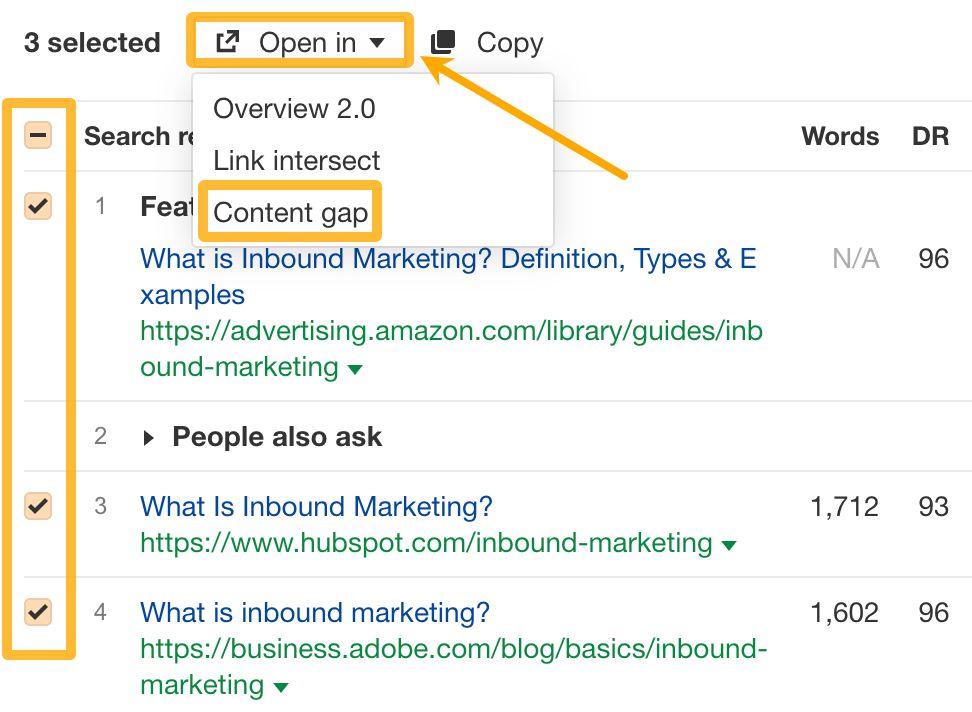
This will open the Content gap report, which shows you the common keywords these three pages are ranking for. Eyeball the report to find relevant subtopics you could cover.

For example, if we were targeting the keyword “inbound marketing,” these would make good subheadings:
- What is inbound marketing
- Inbound marketing examples
- Inbound marketing strategies
- Inbound marketing tools
Google wants to reward pages that bring new information to the table.
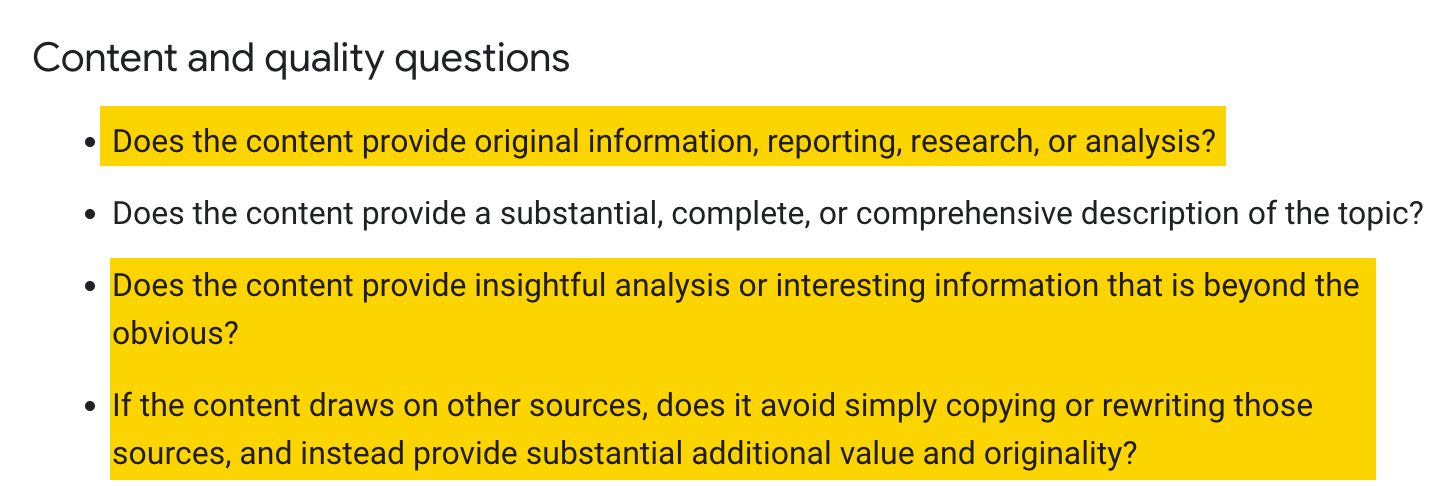
Google’s Helpful Content guidelines specify that Google is looking for original, insightful, or interesting information in content.
At Chiang Mai SEO 2023, SEO Cyrus Shepard shared four ways to add something new to the conversation:
- Make effort
- Be original
- Demonstrate your talent or skill
- Improve accuracy

Here are some ways to show these:
- Interview experts — If you’re not an expert in the industry, interview one. Even better: Interview a few, extract their wisdom, and condense their knowledge into an article.
- Write from experience — For example, if you’re writing about Soylent, try having only the meal replacement for 30 days and write about what happened.
- Run experiments, studies, and polls — Having unique data is one of the easiest ways to include something new.
- Do deep research — Research isn’t remixing the top-ranking pages or asking ChatGPT a few questions. It’s going beyond that: reading books, finding primary sources, listening to podcasts, diving into research papers, and more.
- Be opinionated — Challenge truisms, express your point of view, and back it up with evidence from your expertise or experience.
Sweating already? You should be. Creating high-quality content isn’t supposed to be so easy. As Ryan Law, our Director of Content Marketing puts it:
Great writing should feel hard. If you can crank out an article by opening a few browser tabs, so can everyone else. But interview someone, read a book, find an esoteric research paper, or collect some data… and your willingness to do something difficult gives you an edge.
Before you put pen to paper, you should create an outline. Creating an outline will help you:
- Plan what you want to say (including the angle, headings, subheadings)
- Prevent writer’s block
- Make the writing process faster
By matching search intent, being comprehensive, and writing from a unique angle, you already have the necessary ingredients to create an outline. All that’s left is to put them together.
The easiest way to do this is with ChatGPT. Give it a prompt like:
Write an outline about link building outreach. It should include sections about what link building outreach is, why it is important, how to do it, and additional tips. It should also incorporate my original data where I found that the average conversion rate for link building outreach is 1-5%.
It’ll generate an outline for you:

Pretty good!
Further reading
This stage is about free writing without worrying too much about making the words perfect. Just get it all out.
I always write my drafts in Google Docs. This allows for easy communication between my colleagues, editors, and designers.
If you’re easily distracted, use some of these tricks:
- Download a Pomodoro timer like Marinara to keep yourself focused.
- Use a website blocker like BlockSite to stop yourself from checking X or accessing YouTube.
- Put your phone on airplane mode.
As writers, we often have trouble seeing the wood for the trees. That’s why having a second pair of eyes is helpful.
Getting someone to review your draft can help point out inaccuracies, inconsistencies, failures in logic, phrasing errors, and grammatical mistakes.
You can ask team members or employees to give their feedback. If you have an audience, you can consider getting their feedback as well.
At Ahrefs, each draft goes through at least one person.
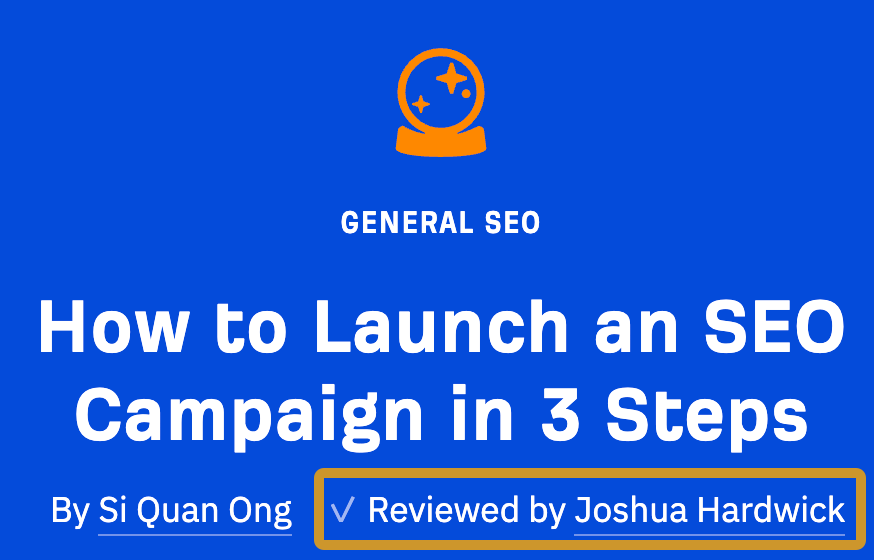
Here’s an example of how we improved the accuracy of our post, thanks to peer feedback:

This will make the content better in Google’s eyes.
Once you get the feedback, revise your writing accordingly and start polishing your article.
Your goal here is to provide the best possible answer in the most efficient way.
Efficient means you want to make it easy for them to consume. Here’s what you can do:
- Add visual elements. You’d want to think about where an image could explore more and illustrate better than words.
- Use bullets and lists (like what I’m doing now.)
- Avoid big words (where necessary). Author Morgan Housel writes: “Big words mask little thoughts. They’re an attempt to fool the reader into thinking you’re smart when you have nothing smart to say.”
- Use Grammarly to fix any grammatical errors
- Use Hemingway to simplify your writing
The title tag and meta description are the first things a searcher sees after Googling their query:

How enticing they are could mean the difference between a searcher clicking through or ignoring your page.
So, you want to make sure both are compelling for your article.
Here are some tips on writing an attractive title tag:
- Keep it short (<70 characters) to avoid truncation
- Tell searchers you have what they want by matching search intent
- Be descriptive but don’t clickbait
- Include the keyword if possible, otherwise use a close variation
If you’re stuck, ask ChatGPT to brainstorm title tags for you and use them as inspiration:
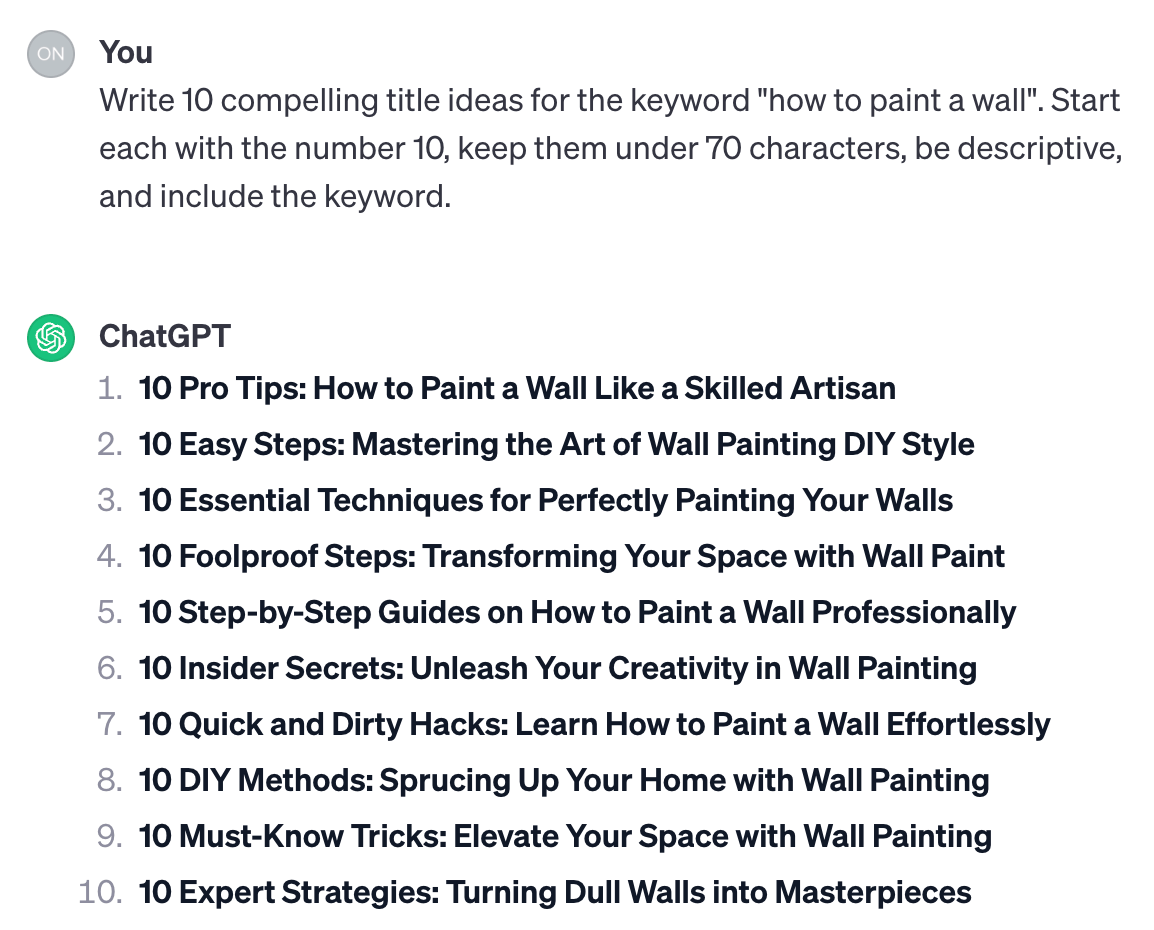
Here are some tips on writing a compelling meta description:
- Keep it under 160 characters to avoid truncation
- Expand on the title tag by including USPs you couldn’t fit
- Double down on what searchers want by matching search intent
- Address the searcher directly via an active voice
- Include your keyword if possible
Again, you can use ChatGPT to brainstorm meta descriptions for you:

Further reading
After your post is published, you should always add internal links from other pages on your site to the new article.
Not only does this make your site user-friendly, but it also helps Google crawl and understand what your new page is about.
Here’s how to find relevant internal link opportunities:
- Sign up for our free Ahrefs Webmaster Tools
- Run a crawl using Site Audit
- When the crawl is done, go to the Internal link opportunities report

This report will show you the page you should link to, the page you should link from, and the keyword context where you can add an internal link.
Go through the report and add your internal links.
Further reading
FAQs
Why is SEO writing important?
If you can write and rank content that searchers are looking for, you’ll get passive, consistent traffic to your website.
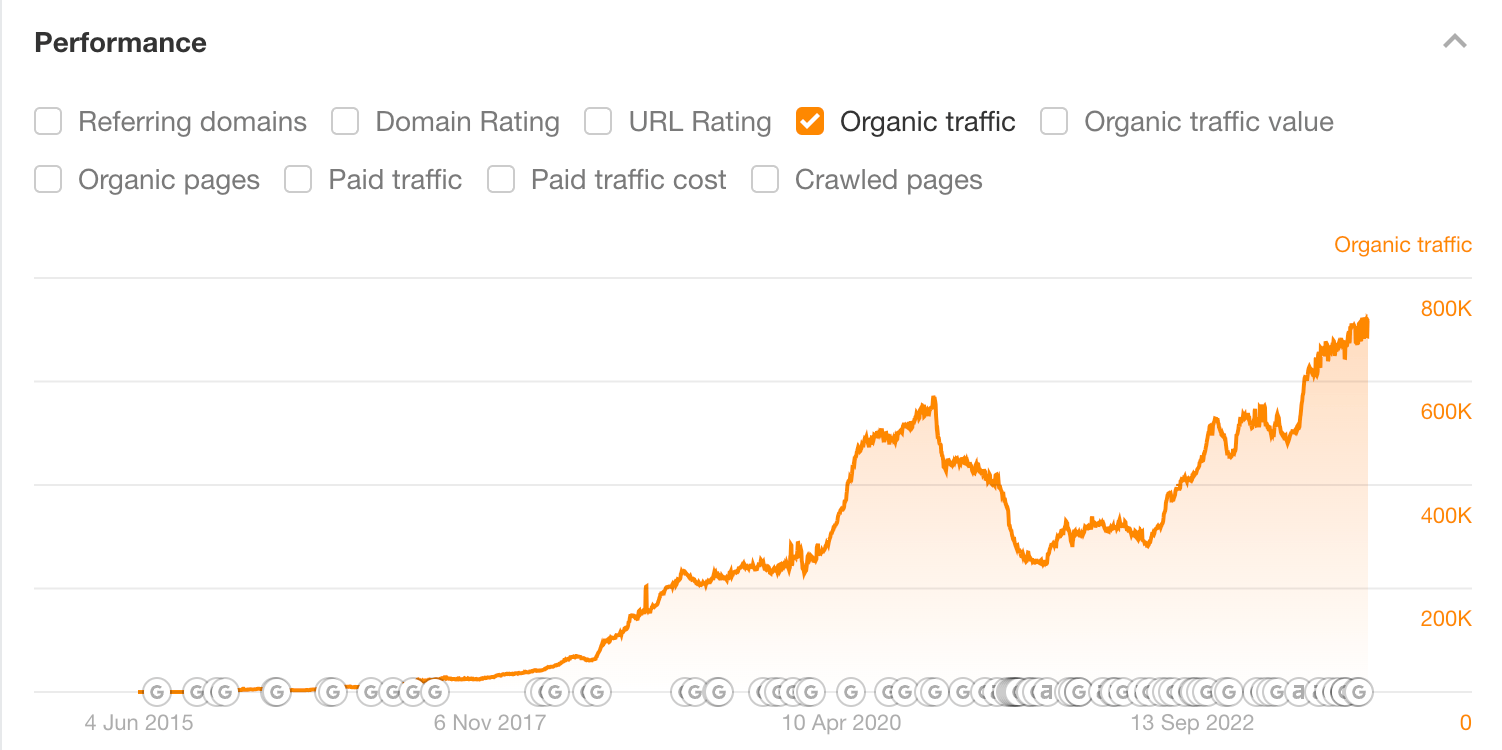
Final thoughts
SEO writing boils down to creating the best possible answer to a given query presented in a way that’s easily understood and skimmable.
As long as you nail that and the basic on-page SEO best practices I mentioned, you’ve mastered the content side of SEO.
If you’re eager to learn more about writing and SEO, check out some of these other guides:
Content Copyrights Belong to The Author. All Rights Reserved.
We're A Dallas Digital Marketing Agency That is Experts At Social Media Marketing, Website Design and Emarketing and Promotion.




